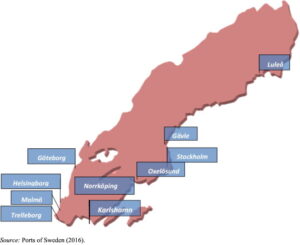Distribution och konsumtion – Distribution and Consumption
Sweden’s product distribution of domestic goods is very organized. Sweden moves products through road/land transport by 64% (39.9 billion t/km), and train transport is by 36% (22.3 billion t/km). Sea transport has a 2.700 km coastline and its many islands, which is essential for Sweden in almost all international transactions and half of the domestic trade shipped by sea transport. Some of the main ports are Stockholm, Göteborg, and Trelleborg, where ships load and unload products (Societe Generale, 2020). Njordvaror trades with Norway, Germany, Denmark, Finland, the United States, Netherlands, and China (OEC, 2020).
Figure 1. Source: Ports of Sweden (2016). Sweden’s Sea Ports. Retrieved December, 2020, from https://www.sciencedirect.com/science/article/abs/pii/S2210539516300827
Sweden imposed a carbon tax and a consumption tax rate of 25% with a reduced tax rate of 12% on clothing and household linen and some foodstuff like fish in the marketplace. The lowest rate of 6% in domestic passenger transportation is newspapers with periodicals, books, cultural events, admitting to sports events, and the use of sports facilities. Zero-rated exports are goods and related services such as the intra- community and international passenger transport, printing, and other services are associated with the production of magazines and medicines supplied on prescriptions or sold to hospitals. Sweden also applies a levy obligation aimed at alcohol, tobacco, fuel, and electricity (Societe Generale, 2020).




